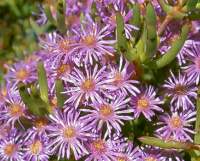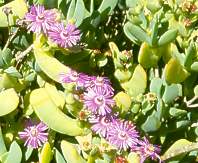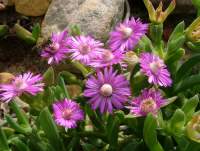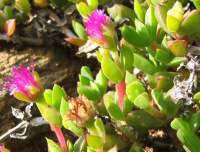Ruschia
Ruschia Schwantes
Family: Aizoaceae
Common names: beesvygie (Afr.)
Introduction
Plants in the Ruschia genus are among the most striking, versatile and diverse of all succulents in the Mesembryanthemum group of the Aizoaceae family.

Description
Description
Due to the large size of the genus, authors have grouped species into several sections, each based on growth habit, flower and capsule form. Plants may vary from large, erect shrubs reaching 1.4 m, to dwarf, tufted and even mat-forming ground cover species. All plants possess mostly woody roots, which are situated very close to the soil surface. Branches are also woody and tough with short internodes that are often covered with dry leaves. There are some species that possess spines as protection against grazing animals. The flowers of Ruschia vary from white to pink and purple. They very much resemble another genus, Lampranthus, but the latter have much bigger flowers and more colour types. Members of Ruschia are all very floriferous; flowers literally cover the entire plant. Flowering takes place throughout the year, reaching a peak in the autumn and spring. Flowers are diurnal (opening during the day) and sweet scented; the leaves are often bluish green, three-sided, sometimes with teeth along the edges, and are nearly always stippled with darker transparent dots, which is an interesting feature in the genus.
The fruits are capsules, which have 5 or rarely 6 locules (chambers), a deep capsule base, and no valve wings. Seeds are yellowish to brownish, 0.5 to 1 mm in diameter, more or less flat and spherical. All plants in this genus are generally fast-growing but short-lived and becoming stocky after four years, especially in arid and semi-arid areas.
Conservation Status
Status
Only about six species in the genus are listed as threatened (Hilton-Taylor 1996). These are: R. amicorum which is listed as rare and occurs in the Cape Floristic Region (CFR); R. filamentosa, another CFR species which is listed as an I (intermediate) i.e. extinct, endangered, vulnerable or rare - the information seems to be insufficient to decide in which category it must go; R. lawsonii, also listed as K, suspected to be in one of the mentioned categories (R. lawsonii is now in the genus Antimima ); R. leipoldtii which is endangered (also in the genus Antimima ); R. promontorii which is endangered and from the CFR; and R. rubricaulis which is an intermediate species from the CFR.
Threats to these species occur mainly as a result of agricultural activities such as unwise grazing practices, or clearing of habitat for agriculture (Chesselet & Smith 2002 ). Species identified as rare are almost always targeted for cultivation in ex-situ conservation projects. These projects form part of a national Threatened Species Program (TSP) currently in operation in all of the eight national botanic gardens of South Africa. The aim is to build up well-represented collections of all threatened taxa that will eventually be used to strengthen wild populations.
Distribution and habitat
Distribution description
Species of Ruschia shows remarkable variability as a result of the different habitats in which they are found. Soil types vary from quartzitic sandstone, calcareous soils, decomposed shale, clay soil, and deep sandy loams. Plants are found in the fynbos, strandveld, renosterveld, grassland, Namaqualand karoo, succulent karoo, savanna and bushveld biomes of South Africa. Geographically their distribution stretches from as far as Windhoek in Namibia to the Western Cape, Eastern Cape, Free State and Gauteng. The highest frequency, however, is found in the drier southwestern region near sea level, with less than 100 mm of annual winter rain. This is significantly different to the other members of the genus occurring in summer rainfall regions that receive up to 800 mm per annum. Ruschia are tolerant of frost, fires and extreme droughts, and this, together with their vibrant colours, make them among the most popular water-wise garden plants known today.

Derivation of name and historical aspects
History
The group Mesembryanthemum was first published as Mesembrianthemum by Breyne in 1684 and is derived from the Greek mesembria meaning midday; anthemom meaning flower, an allusion to the fact that the plants bloomed at noon. Some time after this, night-flowering species became known and this name then seemed inappropriate. In 1719 Delenius ingeniously renamed them Mesembryanthemum: by changing the 'i' to 'y' he altered the derivation to the Greek, mesos, meaning middle, and embryon, embryo, and anthemom, meaning flower. This refers to the position of the ovary, i.e. in the middle. The group today has been segregated into approximately 127 genera of which 95% are confined to the winter rainfall areas of South Africa.
The genus name Ruschia was named in honour of a Namibian farmer by the name of Ernst Julius Rusch (1867-1957). The monotypic genus Ruschianthus was named to commemorate his son Ernst Franz Theodor Rusch (1897-1964). Ruschia is the largest genus in the mesemb family, with about 216 species.
Ecology
Ecology
As with all mesembs, Ruschia species produce colourful flowers that are also scented. Insect pollinators such as bees, flies and butterflies eagerly visit flowers from morning till noon. Plants are designed to withstand heat and drought by employing various strategies. Leaves are reduced to spines in some species (e.g Ruschia spinosa), to minimise water loss and protect plants against grazing animals. Species that are not armed with spines are favourite food for antelope and sheep. Some species have highly reduced leaves (R. crassa.) and use their green stems to fulfil the purpose of leaves. Alternatively leaves are small and orientated in stiff, upright arrangements to minimise surface exposure to the sun. Where rainfall is minimal, plants concentrate the bulk of their roots very close to the surface to ensure rapid uptake of water. Another adaptation in periods of drought stress is when the plants turn a brown or a reddish colour to prevent overheating.
The dispersal of seeds is related to the opening of the capsule through moisture. The capsule keels expand when wet and lift up the valves under which the seeds are kept in small compartments. The raindrops then splash out seeds and they fall to the ground. The process of dispersal by water is only triggered when conditions are suitable, i.e. when rain is sufficient to ensure germination and subsequent establishment of seedlings.
Uses
Use
There seems to be no documented evidence that plants in this genus are used medicinally or for any other purpose. However, it is a known fact that in parts of Namaqualand the Nama people use the tufted and ground cover species that occur naturally in the area as a substitute for thatch e.g. Polymita albiflora. The entire plant is uprooted and densely stacked to waterproof the roof structure of their traditional cooking shelters. Cooking shelters are little huts made from plant material in which the family gathers to prepare meals (a veld kitchen).

Growing Ruschia
Grow
Plants are popular for use in the garden. Their tolerance of drought makes them ideal water-wise plants in the arid and semi-arid parts of the world. Brilliant seasonal colour displays can be achieved by mass planting in large areas and by using many different growth forms. There are tufted, round-shaped plants, which are well suited for containers and flower boxes. The low-growing and spreading species cover well and will do wonders to terraces, embankments and will easily stabilise loose sand. Then there are the bigger, more robust types, which are best used among other larger plants or in combination with other succulents in rock gardens and mixed beds. Remember that plants are short lived and it is therefore essential to continue replanting every three years. As mentioned before all species attract a host of insects, and they are thus ideal subjects to attract wildlife to the garden throughout the year.
Once rooted or germinated, cuttings and seedlings can be fed with organic fertilisers to enhance vigour and health. There are not many serious pests that attack Ruschia. It is probably better to first use biological control when pests are detected. Ladybirds, their larvae and praying mantids prey heavily on small garden pests such as aphids. Birds such as sugarbirds and white-eyes hunt caterpillars and plant-eating bugs. It's really a matter of welcoming wildlife in your garden before resorting to chemicals.
Companion plants to Ruschia include Aloe rupestris, A. microstigma, A. plicatilis, Crassula arborescens, Cotyledon orbiculata, Drosanthemum speciosum, D. bicolor, Lampranthus aureus, L. multiradiatus, Pelargonium betulinum, P. cuculatum, Felcia ameloides and Gazania krebsiana.

The following species are commonly used in the garden:
Species

Ruschia viridifolia has very green leaves and reaches up to 0.6 m. The flowers are pink and appear from summer to autumn. They are ideal filler plants between rocks in sunny positions.

R. caroli is a fast-growing plant up to 0.5 m high with a somewhat spreading habit. The flowers are pink and appear in masses from spring. This species occurs in succulent karoo regions from Clanwilliam to the Little Karoo and is better suited as mass plantings for larger areas.

R. maxima and R. strubeniae have large, succulent leaves and medium-sized pink to purple flowers which appear from autumn to spring. They reach up to 1.5 m high and should be planted in combination with other, bigger plants such as Crassula, Cotyledon, Senecio and Aloe. R. maxima is from dry fynbos areas near Graafwater in the Western Cape and is a species that does very well in cultivation. R. strubeniae is a dry fynbos and renosterveld species occurring from Piketberg.

R. langebaanensis is a pink ground cover species which is well adapted to sandy and coastal conditions and is found in Langebaan, a coastal town on the west coast of the Cape. The species is ideal for stabilising difficult sandy places such as dunes, and can be used in combination with R. caroli.

R. radicans is another species from the west coast, Northern Cape and Namaqualand. It roots easily at its nodes and covers the ground very fast. This species is ideal for terraces, retaining walls and embankments, as it cascades beautifully on angled surfaces. The pink flowers are 13 mm in diameter and appear in spring.

R. lineolata (lineolata means bearing small lines, and refers to the distinctly striped perianth segments), is a procumbent plant forming matted cushions of 0.6 m in diameter. Flowers are purple and 20 mm in diameter. This very attractive species grows on shale ridges of dry streambeds in the renosterveld and succulent karoo. It occurs south of the Langeberg, Robertson and Barrydale Districts.

R. acuminata is a stout shrublet up to 0.3 m high, with erect, floral branches. White to pale pink flowers of about 20 mm across appear in masses from December. It grows on the northern slopes of the Langeberg at the entrance to Robinson Pass in the Little Karoo.

R. centrocapsula is a dwarf, spiny shrublet up to 0.2 m high, with purplish pink flowers which appear in spring. This plant is ideal for very rocky and extremely arid gardens. It occurs in Bushmanland in the Northern Cape.
R. cradockensis subsp. triticiformis is widely distributed from the Eastern Cape to the Sutherland District in the west. It is a very hardy plant up to 0.3 m tall, spiny and rounded with pink flowers in the winter.

R. karooica is an erect plant with stiff stems up to 0.3 m tall. Flowers are large, up to 50 mm across, purplish pink, and appear in August to September. It is found near Matjiesfontein in the southern Great Karoo.

R. knysnana, named after the town of Knysna, is a rigid shrub reaching 0.4 m tall. Flowers are bright reddish pink and 25 mm in diameter, appearing in spring.

R. promontorii is a Cape endemic only known from Cape Point in the Cape Peninsula National Park where it grows abundantly. It is a procumbent (flat or prostrate growing) species that readily roots at the nodes. The stems can reach 0.3 to 0.4 m long. Its flowers are pink-purple in midwinter. This species is another excellent choice for rocky gardens along the Cape Peninsula.

Ruschia spinosa. The spinescent shrublet R. spinosa reaches 0.3 m tall and occurs near Matjiesfontein in the southern Great Karoo. Flowers are smallish, rose pink, and appear in spring. This is another species that is well adapted to very harsh conditions.
References
- Chesselet, P. & Smith, G.F. 2002. The rediscovery of Ruschia acutangula. Bradleya 20: 17-22.
- Court, D. 1981. Succulent flora of South Afica. Balkema, Cape Town.
- Herre, H. 1971. The genera of the Mesembryanthemaceae. Tafelberg, Cape Town.
- Hilton-Taylor, C. 1996. Red Data List of southern African plants. Strelitzia 4. National Botanical Institute, Pretoria.
- Leistner, O.A. (ed.). Seed plants of southern Africa : families and genera. Strelitzia 10. National Botanical Institute, Pretoria.
- Smith, C.A. 1966. Common names of South African plants. Memoirs of the Botanical Survey of South Africa No. 35.
- Smith, G.F., Chesselet, P., Van Jaarsveld, E.J., Hartmann, H., Hammer, S., Van Wyk, B-E., Burgoyne, P., Klak, C. & Kurzweil, H. 1998. Mesembs of the world. Briza Publications, Pretoria.
- Van Jaarsveld, E. & De Villiers Pienaar, U. 2000. Vygies. Gems of the veld. Cactus,Venegano.
Credits
Werner Emil Voigt
Kirstenbosch NBG
November 2005
Plant Attributes:
Plant Type: Succulent
SA Distribution:
Soil type:
Flowering season:
PH:
Flower colour:
Aspect:
Gardening skill:
Special Features:
Horticultural zones






Rate this article
Article well written and informative
Rate this plant
Is this an interesting plant?
Login to add your Comment
Back to topNot registered yet? Click here to register.